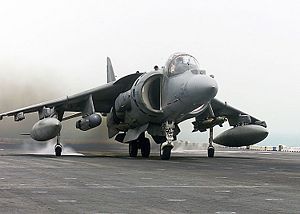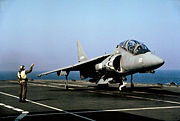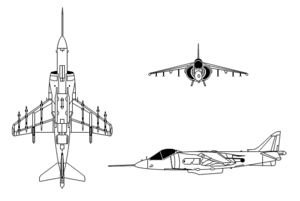AV-8B Harrier II
| AV-8B Harrier II | |
|---|---|
 |
|
| An AV-8B+ Harrier II Plus on the assault ship USS Nassau | |
| Role | V/STOL ground-attack aircraft |
| Manufacturer | McDonnell Douglas / British Aerospace Boeing / BAE Systems |
| First flight | 9 November 1978 (YAV-8B) |
| Introduction | 12 January 1985 (AV-8B) June 1993 (AV-8B+) |
| Primary users | United States Marine Corps Spanish Navy Italian Navy |
| Produced | AV-8B/B+: 1981-2003[1] |
| Unit cost | US$6.7 million in 1988 (AV-8A) US$30-35 million in 1997 (Harrier II Plus)[2] |
| Developed from | Hawker Siddeley Harrier BAE Sea Harrier |
| Variants | BAE Harrier II |
The McDonnell Douglas AV-8B Harrier II is a family of second-generation vertical/short takeoff and landing or V/STOL ground-attack aircraft of the late 20th century. British Aerospace rejoined the project in the early 1980s, and it has been managed by Boeing/BAE Systems since the 1990s.
Developed from the earlier Hawker Siddeley Harriers, it is primarily used for light attack or multi-role tasks, typically operated from small aircraft carriers and large amphibious assault ships. Versions are used by several NATO countries, including the United Kingdom, Spain, Italy, and the United States.
The aircraft is known as the AV-8B Harrier II in United States Marine Corps service and the Harrier GR7/GR9 in British service. Though it shares the designation letter-number with the earlier AV-8A/C Harrier, the AV-8B Harrier II was extensively redesigned by McDonnell Douglas. The AV-8A was a previous-generation Hawker Siddeley Harrier GR.1A procured for the US Marine Corps. These models are commonly referred to as the "Harrier Jump Jet".
Contents |
Development
The Harrier II is notable as an example of US-UK cooperation and of Cold War defense achievements. Of note is the U.S aid funding early development of the Hawker P.1127 under the Mutual Weapons Development Program (MWDP), and the salvaging of what was left of the AV-16 Advanced Harrier Program by McDonnell Douglas, making the second-generation family possible.
McDonnell Douglas had restarted its own program which was nearing production status when British Aerospace (BAe) rejoined the program in the 1980s. They then jointly produced the aircraft. By the 1990s McDonnell Douglas merged with Boeing, and BAe was merged into BAE Systems who went on to manage the family into the early 21st century.

The AV-8B had its direct origins in a joint British-U.S. project (Hawker-Siddeley and McDonnell Douglas) for a much-improved Harrier aircraft, the AV-16. However cost over-runs in engine development on the part of Rolls-Royce and in the aircraft development caused the British to pull out of the program.
Interest remained in the U.S., so a less ambitious, though still expensive project was undertaken by McDonnell on their own catered to U.S. needs. Using knowledge gleaned from AV-16 development, though dropping some items such as further Pegasus development, the development work continued leading to the AV-8B for the U.S. Marine Corps. The aircraft was centered on the Marines' need for a light ground attack aircraft and focused on payload and range, instead of speed. In the early 1980s, the British restarted development of their own second generation Harrier based on the U.S. design which led eventually to the GR.5.
The first two YAV-8B prototypes were converted from existing AV-8A airframes.
Aircraft were built by McDonnell Douglas and British Aerospace (later BAE Systems), the latter at their Kingston and Dunsfold facilities in Surrey, in the UK. The British factories were also home to the Hawker Hunter, and BAe Hawk T1.
Design

The first AV-8B Harrier IIs produced were commonly known as the "Day Attack" variant, and are no longer in service. Most were upgraded to Night Attack Harrier or Harrier II Plus standards, with the remainder being withdrawn from service.
Fielded in 1991, the Night Attack Harrier incorporated a Navigation Forward Looking Infrared camera (NAVFLIR). The cockpit was also upgraded, including compatibility with night vision goggles. Concurrent with the new version of the aircraft was introduced a more powerful Rolls Royce Pegasus II engine. It was originally intended to be designated AV-8D.[3]
The Harrier II Plus is very similar to the Night Attack variant, with the addition of an APG-65 radar in an extended nose, making it capable of operating advanced missiles such as the AIM-120 AMRAAM. The radars were removed from early F/A-18 Hornets, which had been upgraded with the related APG-73. The Harrier II Plus is in service with the USMC, Spanish Navy, and Italian Navy.
The AV-8B cockpit was also used for the early trialling of DVI using a system developed by Smiths Industries.[4]
Operational history
The AV-8B Harrier II is used by the military forces of three nations. The United States Marine Corps has operated the AV-8B and TAV-8B since 1985. The Spanish Naval air wing (Arma Aerea De La Armada) operates the AV-8B and AV-8B+, as well as a leased TAV-8B. The Italian Navy air wing (Aviazione di Marina Militare) also uses the AV-8B+ and TAV-8B.
Variants



- YAV-8B
- Two prototypes converted from existing AV-8A airframes.
- AV-8B Harrier II
- "Day Attack" variant; no longer in service. Most were upgraded to one of the following two variants, while the remainder were withdrawn from service.
- AV-8B Harrier II Night Attack
- Fielded in 1991; incorporates a Navigation Forward Looking Infrared camera (NAVFLIR). Upgraded cockpit, including compatibility with night vision goggles. More powerful Rolls Royce Pegasus 11 engine.
- AV-8B Harrier II Plus
- Similar to the Night Attack variant, with the addition of an APG-65 radar. It is used by the USMC, Spanish Navy, and Italian Navy.
- TAV-8B Harrier II
- Two-seat trainer version.
- EAV-8B Matador II
- Company designation for the Spanish Navy.
Operators
- Italian Navy
- Gruppo Aerei Imbarcati "The Wolves"
- Spanish Navy
- 09th Squadron > 17 planes
- United States Marine Corps
- VMA-211
- VMA-214
- VMA-223
- VMA-231
- VMA-311
- VMA-513
- VMA-542
- VMAT-203
Specifications (AV-8B+ Harrier II Plus)


General characteristics
- Crew: 1 pilot
- Length: 46 ft 4 in (14.12 m)
- Wingspan: 30 ft 4 in (9.25 m)
- Height: 11 ft 8 in (3.55 m)
- Wing area: 243.4 ft² (22.61 m²)
- Airfoil: supercritical airfoil
- Empty weight: 13,968 lb (6,340 kg)
- Loaded weight: 22,950 lb (10,410 kg)
- Max takeoff weight:
- Rolling: 31,000 lb (14,100 kg)
- Vertical: 20,755 lb (9,415 kg)
- Powerplant: 1× Rolls-Royce F402-RR-408 (Mk 105) vectored-thrust turbofan, 23,500 lbf (105 kN)
Performance
- Maximum speed: .89 Mach (662 mph, 1,070 km/h) at sea level
- Range: 1,200 nm (1,400 mi, 2,200 km)
- Combat radius: 300 nmi (556 km)
- Ferry range: 1,800 nmi (3,300 km)
- Rate of climb: 14,700 ft/min (4,485 m/min)
- Wing loading: 94.29 lb/ft² (460.4 kg/m²)
Armament
- Guns: 1× GAU-12U "Equalizer" 25 mm (0.98 in) cannon (left pod) and 300 rounds of ammunition (right pod) (American/Spanish/Italian configuration)
- Hardpoints: 7 with a capacity of 13,200 lb (STOVL) of stores, including gravity bombs, cluster bombs, napalm canisters, laser-guided bombs, AGM-65 Maverick or AGM-84 Harpoon missiles, a LITENING targeting pod, up to four AIM-9 Sidewinder or similar-sized infrared-guided missiles. Radar equipped AV-8B+ variants can carry up to four AIM-120 AMRAAM missiles. An upgrade program is currently fitting airframes with wiring and software to employ 1760 bus-based smart weapons, such as Joint Direct Attack Munitions,
Avionics
- APG-65
Popular culture
The Harrier's unique characteristics have led to it being featured in a number of films and video games.
See also
- Harrier Jump Jet, an overview of the Harrier family
Related development
- BAE Harrier II
- BAE Sea Harrier
- Hawker P.1127
- Hawker Siddeley Harrier
Comparable aircraft
- Boeing X-32
- F-35 Lightning II
- Yakovlev Yak-38
- Yakovlev Yak-141
Related lists
- List of active United States military aircraft
References
Notes
- ↑ Norden 2006, Appendix A.
- ↑ Military aircraft prices
- ↑ Donald, David; Daniel J. March (2004). Modern Battlefield Warplanes. Norwalk, Connecticut: AIRtime Publishing. p. 89. ISBN 1-880588-76-5.
- ↑ Adams, Charlotte (14 December 1997). "Voice-recognition technology: Waiting to exhale", Federal Computer Week, 1105 Media, Inc. Retrieved on 2008-07-15.
- ↑ Norden 2006, Appendix C.
- ↑ "McDonnell Douglas/British Aerospace AV-8B Harrier II Attack Fighter". Aircraft Museum. Aerospaceweb.org (2006-04-01). Retrieved on 2006-10-29.
Bibliography
- Jenkins, Dennis R. Boeing / BAe Harrier. North Branch, Minnesota: Specialty Press, 1998. ISBN 1-58007-014-0.
- Norden, Lon O. Harrier II, Validating V/STOL. Annapolis, Maryland: Naval Institute Press, 2006. ISBN 1-59114-536-8.
External links
- AV-8B Plus product page on Boeing.com
- AV-8B Harrier description and AV-8B Harrier II history page on Navy.mil
- RTP-TV AeroSpace Show: Video of Harrier Hovering
- Defense Industry Daily: AV-8B Harrier finding success in Iraq (30 March 2005)
- The Vertical Vision - a Pulitzer Prize winning article in three parts on the accident-prone Harrier published in 2002
|
||||||||||||||||||||||||||
|
|||||||||||
|
|||||
|
|||||
|
||||||||||||||